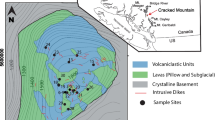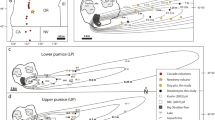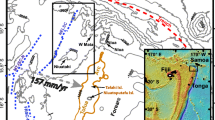Abstract
High-temperature silicic volcanic rocks, including strongly rheomorphic tuffs and extensive silicic lavas, have recently been recognized to be abundant in the geologic record. However, their mechanisms of eruption and emplacement are still controversial, and traditional criteria used to distinguish conventional ash-flow tuffs from silicic lavas largely fail to distinguish the high-temperature versions. We suggest the following criteria, ordered in decreasing ease of identification, to distinguish strongly rheomorphic tuffs from extensive silicic lavas: (1) the character of basal deposits; (2) the nature of distal parts of flows; (3) the relationship of units to pre-existing topography; and (4) the type of source. As a result of quenching against the ground, basal deposits best preserve primary features, can be observed in single outcrops, and do not require knowing the full extent of a unit. Lavas commonly develop basal breccias composed of a variety of textural types of the flow in a finer clastic matrix; such deposits are unique to lavas. Because the chilled base of an ashflow tuff generally does not participate in secondary flow, primary pyroclastic features are best preserved there. Massive, flow-banded bases are more consistent with a lava than a pyroclastic origin. Lavas are thick to their margins and have steep, abrupt flow fronts. Ashflow tuffs thin to no more than a few meters at their distal ends, where they generally do not show any secondary flow features. Lavas are stopped by topographic barriers unless the flow is much thicker than the barrier. Ash-flow tuffs moving at even relatively slow velocities can climb over barriers much higher than the resulting deposit. Lavas dominantly erupt from fissures and maintain fairly uniform thicknesses throughout their extents. Tuffs commonly erupt from calderas where they can pond to thicknesses many times those of their outflow deposits. These criteria may also prove effective in distinguishing extensive silicic lavas from a postulated rock type termed lava-like ignimbrite. The latter have characteristics of lavas except for great areal extents, up to many tens of kilometers. These rocks have been interpreted as ash-flow tuffs that formed from low, boiling-over eruption columns, based almost entirely on their great extents and the belief that silicic lavas could not flow such distances. However, we interpret the best known examples of lava-like ignimbrites to be lavas. This interpretation should be tested through additional documentation of their characteristics and research on the boiling-over eruption mechanism and the kinds of deposits it can produce. Flow bands, flow folds, ramps, elongate vesicles, and probably upper breccias occur in both lavas and strongly rheomorphic tuffs and are therefore not diagnostic. Pumice and shards also occur in both tuffs and lavas, although they occur throughout ash-flow tuffs and generally only in marginal breccias of lavas. Dense welding, secondary flow, and intense alteration accompanying crystallization at high temperature commonly obliterate primary textures in both thick, rheomorphic tuffs and thick lavas. High-temperature silicic volcanic rocks are dominantly associated with tholeiitic flood basalts. Extensive silicic lavas could be appropriately termed flood rhyolites.
Similar content being viewed by others
References
Allen RL (1988) False pyroclastic textures in altered silicic lavas, with implications for volcanic-associated mineralization. Econ Geol 83: 1424–1446
Bacon CR (1986) Magmatic inclusions in silicic and intermediate volcanic rocks. J Geophys Res 91: 6091–6112
Bellieni G, Brotzu P, Comin-Chiaramonti P, Ernesto M, Melfi A, Pacca IG, Piccirillo EM (1984) Flood basalt to rhyolite suites in the southern Parana Plateau (Brazil): palaeomagnetism, petrogenesis and geodynamic implications. J Petrol 25: 579–618
Bonnichsen B, Kauffman DF (1987) Physical features of rhyolite lava flows in the Snake River Plain volcanic province, southwestern Idaho. In: Fink JH (ed) The emplacement of silicic domes and lava flows. Geol Soc Amer Sp Pap 212: 119–145
Bristow JW (1989) Retracing Vulcan's fiery footsteps. Nuclear Active 41: 30–37
Bristow JW, Cleverly FW (1979) Volcanology of the Lebombo Rhyolites. Geol Soc South Africa Geocongress 79: 60–63
Cas RAF (1978) Silicic lavas in Paleozoic flyschlike deposits in New South Wales, Australia: behavior of deep subaqueous silicic flows. Geol Soc Amer Bull 89: 1708–1714
Cas RAF, Wright JV (1987) Volcanic successions; modern and ancient. Allen & Unwin, London, 528 pp
Chapin CE, Lowell GR (1979) Primary and secondary flow structures in ash-flow tuffs of the Gribbles run paleovalley, central Colorado. In: Chapin CE, Elston WE (eds) Ash-flow tuffs. Geol Soc Amer Sp Pap 180: 137–154
Christiansen RL, Hildreth W (1989) Voluminous rhyolitic lavas of broad extent on the Yellowstone Plateau. Continental Magmatism Abstracts New Mex Bur Mines Res Bull 131: 52
Christiansen RL, Lipman PW (1966) Emplacement and thermal history of a rhyolite lava flow near Fortymile Canyon, southern Nevada. Geol Soc Amer Bull 77: 671–684
Cleverly RW, Bristow JW (1982) Flow-banded and contorted tuffs: examples from southern Africa (Lebombo Province) and western North America. Geol Soc Amer Abs w Prog 14: 464
Creaser RA, White AJR (1991) Yardea Dacite — Large-volume, high-temperature felsic volcanism from the Middle Proterozoic of South Australia. Geol 19: 48–51
Crisp JA, Spera FJ (1987) Pyroclastic flows and lavas of the Mogan and Fataga Formations, Tejeda Volcano, Gran Canaria, Canary Islands: mineral chemistry, intensive parameters, and magma chamber evolution. Contrib Mineral Petrol 96: 503–518
Duffield WA (1990) Eruptive fountains of silicic magma and their possible effects on the tin content of fountain-fed lavas, Taylor Creek Ryholite, New Mexico. Geol Soc Amer Sp Pap 246: 251–262
Duffield WA, Dalrymple GB (1990) The Taylor Creek Rhyolite of New Mexico: a rapidly emplaced field of lava domes and flows. Bull Volc 52: 475–487
Ekren EB, McIntyre DH, Bennett EH (1984) High-temperature, large-volume, lavalike ash-flow tuffs without calderas in southwestern Idaho. US Geol Surv Prof Pap 1272
Fink JH (1983) Structure and emplacement of a rhyolitic obsidian flow: Little Glass Mountain, Medicine Lake Highland, northern California. Geol Soc Amer Bull 94: 362–280
Fink JH, Manley CR (1987) Origin of pumiceous and glassy textures in rhyolite flows and domes. In: Fink JH (ed) The emplacement of silicic domes and lava flows. Geol Soc Amer Sp Pap 212: 77–88
Fink JH, Manley CR (1989) Explosive volcanic activity generated from within advancing silicic lava flows. In: Latter JH (ed) Volcanologic hazards: assessment and monitoring. IAVCEI Proc. in Volcanol. 1: 169–179
Fink JH, Pollard DD (1983) Structural evidence for dikes beneath silicic domes, Medicine Lake Highland, California. Geol 11: 458–461
Franklin RR, Self S, Wolff JA (1987) Lava-like tuffs of Trans-Pecos Texas: the Star Mountain Formation. EOS 68: 1544
Franklin RR, Wolff JA, Self S (1989) Recognition and origin of widespread silicic lavas. Geol Soc Amer Abs w Prog 21: 11
Freundt A, Schmincke H-U (1990) The densely welded basaltic ignimbrite P1 on Gran Canaria. Int Volc Congr abs Mainz (FRG)
Green JC (1989) Physical volcanology of mid-Proterozoic plateau lavas: the Keweenawan North Shore Volcanic Group, Minnesota. Geol Soc Amer Bull 101: 486–500
Green JC, Fitz TJ (1989) Large rhyolites in the Keweenawan midcontinent rift plateau volcanics of Minnesota — lavas of rheoignimbrites. New Mex Bur Mines Min Res Bull 131: 113
Hargrove HR, Sheridan MF (1984) Welded tuffs deformed into megarheomorphic folds during collapse of the McDermitt caldera: Nevada-Oregon. J Geophys Res 89: 8629–8638
Heiken G, Wohletz K (1987) Tephra deposits associated with silicic domes and lava flows. In: Fink JH (ed) The emplacement of silicic domes and lava flows. Geol Soc Amer Sp Pap 212: 55–76
Henderson GD (1987) Intracaldera kaolinization and silicification of ash-flow tuff, Medley area, Davis Mountains, Texas. Geol Soc Amer Abs w Prog 19: 170
Henry CD, Price JG, Rubin JN, Parker DF, Woff JA, Self S, Franklin R, Barker DS (1988) Widespread, lava-like volcanic rocks of Trans-Pecos Texas. Geol 16: 509–512
Henry CD, Price JG, Parker DF, Wolff JA (1989) Mid-Tertiary silicic alkalic magmatism of Trans-Pecos Texas: rheomorphic tuffs and extensive silicic lavas. In: Chapin CE, Zidek J (eds) Field excursions to volcanic terrains in the western United States, I: Southern Rocky Mountain region. New Mex Bur Mines Min Res Mem 46: 231–274
Henry CD, Price JG, Rubin JN, Laubach SE (1990) Case study of an extensive silicic lava: the Bracks Rhyolite, Trans-Pecos Texas. J Volcanol Geotherm Res 43: 113–132
Aonjo N, Bonnichsen B, Leeman WP, Stormer JC (1992) Mineralogy and geothermometry of high-temperature rhyolites from the central and western Snake River Plain. Bull Volcanol 54: 220–237
Leat PT, Schmincke H-U (1990) Emplacement of strongly welded ignimbrite E, Mogan Formation, Gran Canaria. Int Volc Congr abs Mainz (FRG)
Lofgren GE (1980) Experimental studies on the dynamic crystallization of silicate melts. In: Hargraves RB (ed) Physics of magmatic processes. Princeton, Princeton Univ. Press, pp 487–551
Mahood GA (1984) Pyroclastic rocks and calderas associated with strongly peralkaline magmatism. J Geophys Res 89: 8540–8552
Mahood GA, Hildreth W (1986) Geology of the peralkaline volcano at Pantelleria, Strait of Sicily. Bull Volcanol 48: 143–172
Manley CR (1989) Cooling, devitrification, and flow or large, hot rhyolite lava flows: numerical modeling results. New Mex Bur Mines Min Res Bull 131: 174
Manley CR (1990) Exposed vent area for a voluminous rhyolite lava flow: the ‘tuff of the Badlands, Owyhee Plateau, southwest Idaho? Geol Soc Amer Abs w prog 22: A290
Manley CR, Fink JH (1987) Internal textures of rhyolite flows as revealed by research drilling. Geol 15: 549–551
Milner SC (1986) The geological and volcanological features of the quarz latites of the Etendeka Formation. Comm Geol Surv Southwest Africa/Namibia 2: 109–116
Milner SC, Duncan AR, Ewart A (1992) Quartz latite rheignimbrite flows of the Etendeka Formation, north-western Namibia. Bull Volcanol 54: 200–219
Orsi G, Sheridan MF (1984) The Green Tuff of Pantelleria: rheoignimbrite or rheomorphic fall? Bull Volcanol 47: 611–626
Parker DF (1986) Stratigraphic, structural, and petrologic development of the Buckhorn caldera, northern Davis Mountains, Trans-Pecos Texas. In: Price JG, Henry CD, Parker DF, Barker DS (eds) Igneous geology of Trans-Pecos Texas. Univ Texas Austin Bur Econ Geol Guideb 23: 286–302
Parker DF, McDowell FW (1979) K-Ar geochronology of Oligocene volcanic rocks, Davis and Barrilla Mountains, Texas. Geol Soc Amer Bull 90: 1100–1110
Petrini R, Civetta L, Iacumin P, Longinelli A, Bellieni G, Comin-Chiarmonte P, Ernesto N, Marques LS, Melfi A, Pacca I, Piccirilo EM (1989) High temperature flood silicic lavas (?) from the Parana Basin (Brasil). New Mex Bur Mines Min Res Bull 131: 213
Pieri DC, Baloga SM (1986) Eruption rate, area, and length relationships for some Hawaiian lava flows. J Volcanol Geotherm Res 30: 29–45
Rowley PD, Kuntz MA, MacLeod NS (1981) Pyroclastic flow deposits. US Geol Surv Prof Pap 1250: 489–512
Sampson DE (1987) Textural heterogeneities and vent area structures in the 600-year-old lavas of the Inyo volcanic chain, eastern California. In: Fink JH (ed) The emplacement of silicic domes and lava flows. Geol Soc Amer Sp Pap 212: 89–101
Schmincke H-U (1974) Volcanological aspects of peralkaline silicic welded ash-flow tuffs. Bull Volcanol 38: 594–636
Schmincke H-U, Swanson DA (1967) Laminar viscous flowage structures in ash-flow tuffs from Gran Canaria, Canary Islands. J Geol 75: 641–664
Self S, Wolff JA, Spell TL, Skuba CE, Morrissey MM (1991) Revisions to the stratigraphy and volcanology of the post-0.5 Ma units and the volcanic section of VC-1 corehole, Valles Caldera, New Mexico. J Geophys Res 96: 4107–4116
Shaw HR (1972) Viscosities of magmatic silicate liquids: an empirical method of predicton. Amer J Sci 272: 870–893
Smith RL (1960) Ash flows. Geol Soc Amer Bull 71: 795–842
Sparks RSJ, Wilson L (1976) A model for the formation of ignimbrite by gravitational column collapse. J Geol Soc London 132: 441–452
Sparks RSJ, Wilson L, Hulme G (1978) Theoretical modeling of the generation, movement, and emplacement of pyroclastic flows by column collapse. J Geophys Res 83: 1727–1739
Trigila R, Walker GPL (1986) The Onano spatter flow, Italy: evidence for a new ignimbrite depositional mechanism. Int Volc Congr New Zealand abs 81
Twist D, Bristow JW, Van der Westhuizen W (1989) High-temperature flow banded ash-flow tuffs: a review of occurrences in southern Africa. New Mex Bur Mines Min Res Bull 131: 273
Twist D, Elston WE (1989) The Rooiberg Felsite (Bushveld Complex): textural evidence pertaining to emplacement mechanisms for high-temperature siliceous flows. New Mex Bur Mines Min Res Bull 131: 274
Twist D, French BM (1983) Voluminous acid volcanism in the Bushveld Complex: a review of the Rooiberg Felsite. Bull Vocanol 46: 225–242
Walker GPL (1973) Lengths of lava flows. Phil Trans R Soc London 274: 107–118
Walker GPL, Heming RF, Wilson CJN (1980) Low-aspect ratio ignimbrites. Nature 283: 286–287
Walker GPL, Self S, Frogatt PC (1981) The ground layer of the Taupo ignimbrite: a striking example of sedimentation from a pyroclastic flow. J Volcanol Geotherm Res 10: 1–11
Whittingham AM (1989) Geological features and geochemistry of the acidic units of the Serra Geral volcanic formation, south Brazil. New Mex Bur Mines Min Res Bull 131: 293
Wilson L, Head JW (1981) Ascent and eruption of basaltic magma on the Earth and Moon. J Geophys Res 86: 2971–3001
Wilson L, Sparks RSJ, Walker GPL (1980) Explosive volcanic eruptions, IV. The control of magma properties and conduit geometry of eruption column behavior. Geophys J R Astr Soc 63: 117–148
Wolf T (1878) Der Cotopaxi und sein letzte eruption am 26 Juni 1877. Neues Jahr Mineral Geol Palantol 113–167
Wolff JA (1983) Petrology of Quaternary pyroclastic deposits from Tenerife, Canary Islands. PhD thesis London Univ 542 pp
Wolff A (1989) Origin of widespread silicic lavas and lava-like tuffs. New Mex Bur Mines Min Res Bull 131: 297
Wolff JA, Davidson JP (1990) Intraplate geochemical signature in pre-extensional Cenozoic lavas of Trans-Pecos Texas. Geol Soc Amer Abs w Progs 22: A166
Wolff JA, Horn M (1991) Modelling volcanic agglutinates. Geol Soc Amer Abs w Progs 23: 107
Wolff JA, Wright JV (1981) Rheomorphism of welded tuffs. J Volcanol Geotherm Res 10: 13–34
Wolff JA, Warner G, Blake S (1990) Gradients in physical parameters in zoned felsic magma chambers: implications for evolution and eruptive withdrawal. J Volcanol Geotherm Res 43: 37–55
Author information
Authors and Affiliations
Rights and permissions
About this article
Cite this article
Henry, C.D., Wolff, J.A. Distinguishing strongly rheomorphic tuffs from extensive silicic lavas. Bull Volcanol 54, 171–186 (1992). https://doi.org/10.1007/BF00278387
Received:
Accepted:
Issue Date:
DOI: https://doi.org/10.1007/BF00278387




